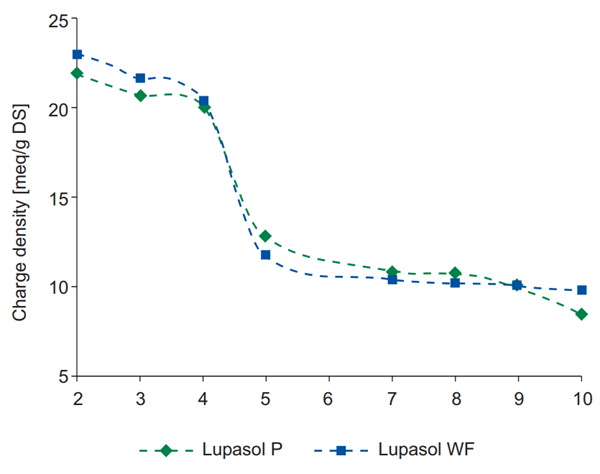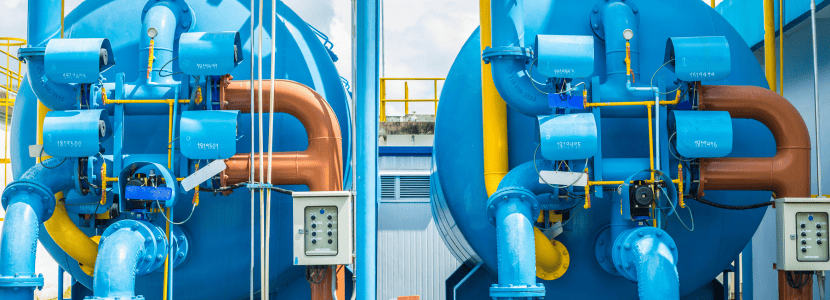Select Your Region
Polyethylenimine: Versatile Polymer Chemistry
What Is Polyethylenimine?
Polyethylenimine (PEI) is a cationic polymer with a highly branched polymer structure. It has a nitrogen to carbon ratio of 1:2, giving it the largest possible amino group density among commercially available polyamine polymers. PEI’s chemical composition can be described by the formula -(CH2-CH2-NH)n-, where 10 < n < 10^5. As depicted in figure 1, PEI contains primary, secondary, and tertiary amino groups. When placed in solutions, these amino groups can generate a significant cationic charge, especially at low pH, as detailed in figure 2, which is based off BASF’s Lupasol® PEI. As pH drops, the tertiary, secondary, and primary amino groups become increasingly protonated, with cationic charge building proportionately. At lower pH, certain PEI grades can exhibit a theoretical charge density of 23 mEq/g, which is among the highest cationic charge density of any polymer, as shown in figure 3. In many applications, the high cationic charge density provides PEI with its functionality and vast utility.

Figure 1

Figure 2

Figure 3
What Is Polyethylenimine Used For?
Polyethylenimine is used in a vast number of applications that leverage its high cationic charge density. Below is a list of industrial and research applications in which PEI is used.
• Primers and coatings
• Printing inks
• Adhesives
• Water treatment
• Carbon sequestration
• Gene delivery

Compatibilization and Adhesion Promotion
In coating, ink, and adhesive applications, PEI functions as a compatibilizer and an adhesion promoter. In these applications, a polymeric film is deposited onto substrates typically made from fiber, plastic, or metal. These substrates can be negatively charged, due to functional groups present on their surfaces or oxidation, which happens naturally following processing. In cases where the coating, ink, and adhesive polymeric films are negatively charged, PEI can be incorporated into formulations or be used as a primer to form strong chemical bonds that adhere and compatibilize materials together to increase durability or visual quality. For more information on these applications and the mechanism of application, visit the following links.
BASF Lupasol® Adhesion Promotion Additives, Product Article - ChemPoint
BASF Lupasol® P - Packaging Film Adhesion Promoter, Product Article - ChemPoint
BASF Lupasol® UV-Curable System Primers - ChemPoint
BASF Lupasol® Inkjet Ink Performance, Product Article - ChemPoint
BASF Lupasol® P - Packaging Film Adhesion Promoter, Product Article - ChemPoint
BASF Lupasol® UV-Curable System Primers - ChemPoint
BASF Lupasol® Inkjet Ink Performance, Product Article - ChemPoint

Flocculation
When placed in solutions containing anionic particles, such as silicates, zeolites, or metal ions, PEI polymers will create chemical bonds due to their cationic charge, enabling them to be leveraged in flocculation applications. In water treatment applications, for example, PEI may be added to effluent to flocculate anionic particulate more effectively than other polymers used, such as polyamines and polyacrylamides. In cooling tower and industrial wastewater applications, minerals can form reversible complexes with PEI to provide purification. For more information on PEI’s use as a flocculant, visit the following link.
BASF Lupasol® - Water Treatment, Product Article - ChemPoint

Other Functionalities
The cationic charge of PEI also lends itself to applications that exhibit benefits in areas such as biological and environmental science. In the field of biotechnology, PEI has been used as a nonviral vector for gene delivery, where its cationic charge adsorbs DNA and RNA, which are negatively charged. Once adsorbed, a structure called a polyplex is formed, enabling uptake into cells. Similar to the adhesion-promoting capability described in the previous section, PEI also helps chemically bond and improve the adherence of cell structures to culture plates. Recently, PEI has also been explored as an adsorption medium for CO2 sequestration. The relatively basic amino groups on PEI can react with CO2—a slightly acidic gas—to form carbamates in the absence of water or carbamates or bicarbonates in the presence of water. CO2 adsorption onto PEI is a reversible process, capable of releasing CO2 once heated.

Lupasol® Polyethylenimine
ChemPoint is a specialty chemical distributor dedicated to helping formulators and engineers find the necessary tools and ingredients needed to innovate and improve their products. We offer Lupasol® polyethylenimine, manufactured by BASF, in a variety of molecular weights, percentage active content, and viscosities. We are happy to offer samples, pricing, and technical assistance with formulation. Click below to reach out to one of our technical experts to ask questions about polyethylenimine.
Thank you
Thank you for your inquiry and interest in ChemPoint.
We will respond to you shortly.
ChemPoint will not under any circumstances release personal user information to individuals or companies. All information collection is solely used to support ChemPoint customers service communications. Read our Privacy Notice.
Are you in the correct region?
We’ve detected that you are located in a different region than the region selected on the website. Would you like to change your region?
Current Region: English - Mexico